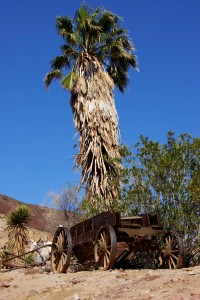Many techniques and technologies for getting gold out of wherever it’s found, have evolved since the first goldrush. The amateur prospector can still enjoy a great deal of fun by panning, crevicing and dowsing for gold. Those with an eye to higher yields or more “professional” operations, might choose another method.
Sluicing
One of the first labour saving devices invented by gold miners was the sluice box, through which a river might be diverted to pour water over the sand and gravel shovelled into them. The gold prospector today, can still make use of a hand sluice box, made in a convenient size for carrying to your potential gold mining sites. The box is constructed in a trough shape, with an open end chute where the unwanted material sloughs off. Dirt and sand is shovelled into the box, and water flows in from one end, to run over the raised ridges down the center, which impede the movement of heavier bits of black sand and gold. Once the material in the sluice has been washed down to the basic heavy bits, it can be panned for the “real” gold.
Dredging
The first gold prospectors were only able to reach the shallow parts of rivers and streams that may have been even richer in ore than they suspected. But it wasn’t too many years, before logic told them that a heavy mineral, washed by moving water, was not going to lie on surfaces in the shallows. From the early 1900s, there are reports of steam driven dredges in northern California, as well as deep sea type divers outfitted in their cumbersome helmets and diving suits, trying to sift out the gold from the river beds.
While dredging has been around for years, it’s only recently enjoyed a boom in popularity, due mostly to the technology that has made the equipment less expensive, more functional, and more portable. Two of the basic types of dredges are:
Surface
the dredge floats on the surface, with material brought up to it from the riverbed via a suction hose, and deposited into a sluice box. Some more modern models may have multi-level sluice boxes that have a greater capability for sifting apart the finer particles. It can be operated from above water, and is easily managed by one person.
Underwater
the submersible unit is less popular, and cumbersome to work. It must remain underwater, and does not operate well in shallows. It consists mainly of a flared metal or plastic tube with a metal elbow, bent at 45-60 degrees. This makes it less flexible in use, unable to get at hard to reach places or around corners. High-pressure water is blasted into the tube by a pump attached to a float on the surface, creating a vacuum at the extreme end of the bend. At the edge of the flared end, are a series of gold traps with riffles, like a sluice box. The heavier particles drop into the traps and lighter ones are blown out and back into the river.
Drywashing
Gold isn’t always found convenient to hand on top of the ground, or lying in a shallow stream. Many of the first strikes were made in desert territory, or areas so dry they had to find another way to “wash” the gold out of the deposits. Having only air flow and vibration to work with, miners constructed rough boxes to shake off some of the unwanted dirt, but were still faced with separating the leftovers, which were often covered in damp soil, too heavy to be shifted by wind. Today, drywashing is carried out with the aid of dry processing machines, which utilise the same principles of vibration, but incorporate heat to remove the moisture and loosen more of the dirt for removal. It’s still not the most effective method of recovery, but it does work.
Highbanking
This is another version of sluicing, using basically the same tools, but not right on or in the water. The highbank sluice box manufactured commercially, generally comes on legs, and is fixed at a level that makes it more comfortable to dump buckets of dirt into, and it’s adjustable for the right flow of water. But instead of using the natural flow of a river or stream, you must introduce the water yourself, either by pumping it from somewhere, or by the bucketful, to wash and separate the material. Another advantage to the highbank sluice, is that it comes with its own classifier over the trough, breaking the sorting job down by removing the large pieces of rock and debris so that there is less water washing needed for the separation process. It is also a viable alternative in areas where it is now illegal to wash silt back into a waterway.
Leaching
Is the chemical process of removing gold from ore. Currently 80% of the world’s gold is recovered this way. It is also a process best left to the experts, as witnessed by the mercury poisoning fallout from old mines, and the gigantic cyanide spills from modern day gold mining tail ponds. Not only are substances like cyanide hard to obtain for the amateur prospector, they are dangerous to handle. Mercury has a lethal vapor, and the nitric acid used to clean it is also dangerous.

Post a Comment